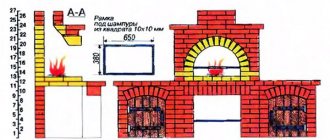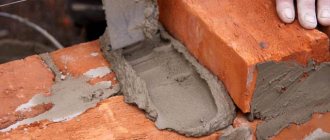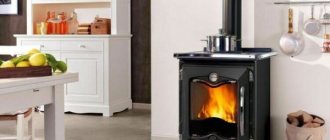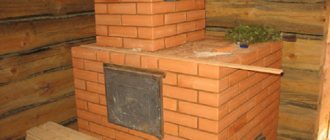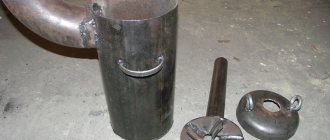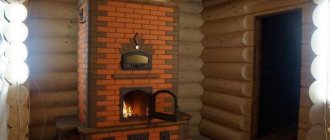Residents of private houses do not always connect gas heating. Therefore, an alternative is to install a brick stove for a wood-burning cottage. Some homeowners install the equipment as additional heating equipment. There are several types of brick stoves for heating different rooms and areas.
A Russian stove will not only heat the house, but with its help you can prepare a delicious lunch and bake a loaf Source zen.yandex.ru
Advantages of stove heating
Wood burning stoves heat up quickly and distribute heat over a long period of time. The brick emits radiant energy, which is good for health. A house where a stove is installed is always comfortable and warm. Thanks to draft, natural ventilation is created in the room. The designs often have a hob on which food can be prepared. In addition, such a stove can be used to dry clothes, shoes and food.
A combination oven is a device that has several functions. This includes a fireplace stove, a heating and cooking stove and a Russian stove.
The only significant drawback is poor heating of remote rooms. That is why they try to install the entire structure in the center of the house for uniform heat transfer. In large houses, it is advisable to install several stoves that have a combined chimney. The hob is usually installed towards the kitchen.
Heating equipment differs in appearance and design.
Usually the stove is installed between several adjacent rooms so that they all heat up evenly Source pechnoy.guru
Dutch oven
The design is one of the most popular. Some models are equipped with a hob and oven, which solves the problem of cooking, but the classic “Dutch” is used only for heating.
The duct-type firebox heats the walls perfectly. The smoke is discharged through a vertical channel, in which almost all of it burns. Although brick stoves for wood-burning homes are usually large in size, the same cannot be said about the Dutch stove, so it is optimally suited for comfortable heating of a private house - one or two floors. Outwardly, the Dutch woman resembles a column. The shape of the structure can be round, square or rectangular.
Advantages of a Dutch woman:
- After long breaks, you can start firing the stove at full power.
- A small structure can heat a house of 70 square meters. m.
- Economical. Low material consumption. The installation price is lower, as well as saving space.
- The design has thin walls, so it warms up quickly.
Classic “Dutch” stoves take up less space, but they are used only for heating the house Source ar.decoratex.biz
Disadvantages:
- The efficiency is no more than 40%.
- You should not forget about cleaning the stove from ash, as well as soot for normal draft.
- The most effective mode is smoldering. This design is often called a long-burning furnace.
- After heating, you need to close the view, otherwise the stove will quickly cool down.
This equipment can be used to heat small houses that have 2 floors or an attic floor.
Russian stove
It is large in size and multifunctional, and also has smoke channels and an open firebox. It is sometimes closed with a flap. The equipment may have a hob.
In addition to heating the room, this design allows you to cook food and dry clothes.
The efficiency is maximum 60%. In winter, the stove must not be allowed to cool down, so it should be fired regularly. If the structure cools down, condensation may occur. The brick becomes saturated with moisture, and upon subsequent cooling it freezes and cracks.
In summer, you can use the oven in summer mode for cooking. In this case, the smoke is directed directly into the chimney using a damper, and the body of the structure does not heat up.
Modern Russian stove with a stove bench in a wooden house Source yandex.ru
Advantages:
- With timely heating, a comfortable microclimate and temperature are created in the house.
- Multifunctional design.
- A brick stove for a summer house decorates the room.
Flaws:
- High installation cost due to the large volume of bricks.
- Due to the large weight and size, it is necessary to build a solid foundation.
- Low efficiency.
- The ducts and chimney must be cleaned regularly.
Such equipment is suitable for year-round use.
See also: Contacts of construction companies that offer installation services for fireplaces and stoves.
Swedish oven
The stove has a universal design and is designed primarily for efficient operation in small areas. The standard “Swedish” is equipped with an oven, hob, and niches for drying things. Some Swedes have a couch and a fireplace.
The principle of operation of a Swedish stove is approximately the same as that of a bell-type stove - combustion of flue gases occurs under the arch of the firebox.
Design advantages:
- The room heats up very quickly.
- Possibility of cooking both on the hob and in the oven.
- Almost complete combustion of fuel.
- Thanks to the design of the channels, the lower part of the equipment is heated, and, consequently, the floors are slightly heated.
- A heat exchanger can be installed in the design to heat water.
The Swedish brick stove has its own characteristics, but it copes well with heating the house Source mauro-gianvanni.ru
Cons:
- To prevent heat loss through the floor, it is necessary to install high-quality thermal insulation.
- For the installation of heated elements, fireclay bricks are used, which have a higher cost.
- Experts recommend leaving the stove always warm in winter. Firing a cold stove can lead to deterioration of the masonry.
Bell furnace
One of the modern designs is such a stove. The equipment heats up well and retains heat for a long time. The design does not have small winding channels, therefore, they are not so susceptible to soot settling.
The principle of operation of a bell-type furnace: smoke rises from the firebox, then remains there until it cools. And then it begins to descend along the walls of the chimney, thus heating it. Such designs are effective because they can have several caps.
Advantages:
- Low cost of material and installation. Simplicity of design.
- You can install a heat exchanger and a hob.
- Heats up quickly even after completely cooling.
- The gas view prevents reverse draft. This is why the oven cannot cool down when the damper is open.
Modern hand-made stoves provide the ability to heat several rooms in the house at once Source mauro-gianvanni.ru
Such a stove can have several hoods, and, therefore, it will be possible to heat 2 floors and several rooms. It is difficult to identify any shortcomings, which is why the bell-type model is popular among homeowners.
About functionality and queries
A stove is, at its core, a tool. Very specialized. Therefore, when considering possible projects, it is important to understand that an infinitely universal tool does not exist in principle. And it is impossible to create it.
Each is optimal for solving certain problems. And adding additional options to one degree or another reduces the effectiveness of the device in the basic, fundamental sector for which the tool was originally optimized.
Household stoves are divided into two groups: heating and heating and cooking. It is clear that only the second option is of interest as a candidate for installation in the kitchen. Still, heating alone is not enough in the kitchen. The ability to prepare food is also desirable. If not as the main platform, then as an additional one.
In theory, a stove array can fit a lot of useful things: a large stove for a cauldron or a multi-burner deck for all kinds of saucepans, a smokehouse, an oven, a bread chamber, a hot water box, a barbecue, a dryer, a kitchen hood and a host of other things limited only by imagination designer.
But, for each of these implantations you will have to pay something: increased volumes and weight, decreased reliability, loss of heat transfer, increased complexity of operation, the need for frequent preventive maintenance and other roughnesses that are not very pleasant from the user’s point of view.
There is a fairly simple way to more or less bypass all the technical bottlenecks in the project, condensing the functionality as much as possible and providing separate, independent services. That is, simply put, by arranging many specialized ovens not in one building, but as densely as possible, just like dorm rooms.
But such a solution is more suitable for a summer kitchen, in which, due to the available space, a garden barbecue oven with a lot of posts lined up in a row or somehow cleverly bent can easily fit.
Of course, if there is excess free space, then you can arrange a whole complex of stoves in a row, united by a single front wall. With formal unity, these will be independent structures that work independently of each other. The only things that will be common are design and geography.
The solution considered is, of course, possible. But it is of little use for more modest volumes - not every small kitchen will be able to accept a substantial mass of brick without compromising habitability - the space for maneuver will be sharply reduced. So you will have to think about something that runs from a single firebox, after which hot gases are directed in such a way as to warm up various services.
And here again there is a difficulty - you cannot direct the gases to heat everything at once. You will have to maintain some consistency, sort of set priorities. And then something will inevitably begin to heat up according to the residual principle - how much heat will be received after warming up other structural elements.
Another point that is not always paid attention to. Thermal power of the furnace. Therefore, you will have to think about whether the stove will become the basic heating method. If yes, then its heat transfer should correspond to the heat loss of the room.
It’s a little easier if this condition is not critical. That is, the stove is either provided as backup heating, or is not considered as a heater at all. But then the question of comfort arises again - a heated stove in a small volume, already heated, will create such an atmosphere that not everyone can withstand it. Therefore, here it is better to get by with something more modest, but wrapped in additional layers of thermal insulation.
We evaluate the possible location in advance. Of course, the stove in the corner seems to be the most optimal option for arranging the space, but again there are subtle places that are thought about in advance:
- corner placement is vulnerable from the position of optimal heat transfer and organization of air convection. Where the heating characteristics of the stove are important, it is still better to place it in the center;
- Corner placement is not always possible. Although, according to the kitchen plan, it seems to suggest itself. It is worth remembering that it is undesirable (especially during irregular use) to place the stove and its pipe against an external wall. Even if a pipe is adjacent to a wall, it is better if it is adjacent to an internal one. And if we are talking about a corner where both walls are street, then this is completely unacceptable. Under such conditions, even the most advanced system will refuse to work stably.
Is it possible to build long-burning brick stoves?
Every homeowner wants to install heating that does not require much labor. Arranging this in a long-burning wood-burning home stove made of brick is quite problematic. Industrial furnaces made of metal that operate on this principle produce carbon monoxide. A long burning mode can be arranged in a Russian or Dutch oven. But this method is not 100% effective. Therefore, it is recommended to install a standard brick stove, which retains heat for a long time.
Chimney pipe
Installing a chimney can be very simple. For this type of stove, a metal pipe with a diameter of 11.5 cm is suitable. It is also worth considering an asbestos cement pipe; this type is most applicable. The height of the chimney itself above the roof is 50 cm.
Basic masonry techniques
In production, heat-resistant and fire-resistant materials for the firebox, as well as hardened bricks, are used. It is not recommended to build a stove yourself. It is necessary to contact specialists for high-quality and safe masonry.
Specialists carry out work in compliance with all safety standards and regulations. For laying bricks, cement mortar is used, which is diluted with sand in a ratio of 1 to 3.
For binding material, many craftsmen use clay and sand.
Each row of bricks is laid out in a certain way to form a stove for a given project. Source pechki.net.ru
What you need to purchase to build a stove
First you need to purchase masonry mortar and bricks. The amount of material will be calculated by a specialist. Do not forget about constructing a separate foundation for installing the furnace. The equipment will require cast iron elements: a door for the firebox, a blower (ash pan door), rings for the burner, a chimney valve, a grate and a hob.
In addition, it is necessary to purchase steel elements: a hot water tank and an oven. When building a structure, you will need strips made of metal of different widths and lengths. A corner made of metal of standard size 0.5 x 0.5 cm. Annealed steel wire with a diameter of 0.2 - 0.3 cm. A sheet of steel must be placed before the firebox.
Some designs may require roofing iron to cover the cooking chamber.
The required amount of material is calculated by a specialist based on the size and type of oven.
Long-burning wood-burning brick stoves for homes are built from fireclay and red bricks, clay and sand. To build the foundation you will need sand and cement, crushed stone, roofing felt, as well as boards for formwork.
Doors and gratings (grids) are mounted along the masonry of the main structure Source extracraft.ru
About designs that tend to be installed in the kitchen
Reinventing the wheel in the furnace business is difficult. But, to tell the truth, there is no point in such efforts in principle - everything has already been invented, tested and brought to mind long before our days - the peak of the heyday of stove heating occurred at the turn of the 19th-20th centuries. Our ancestors had the time and incentive to understand the laws of the process and adapt the design to solve specific problems in the most optimal way.
For a long time, kitchen stoves differed little from those preserved by Vesuvius in Pompeii, Stabia and Herculaneum in 79. Essentially, it was a non-flammable pedestal with a tripod stand on which the dishes were placed. On the surface of the pedestal, under pots raised by a tripod, a fire was made - almost a simple fire. Only ennobled.
Later, when the American John Flavel invented an almost modern kitchen stove (based on the 1800 model of Benjamin Thompson), and the chef of the English Reform Club Alesis Sawyer improved it, people were able to cook, bake, heat, fry on a stove powered by one firebox. And all modern wood-burning kitchen fires still use this pattern of hot gas movement, discovered at the beginning of the 19th century.
Kitchen heating and cooking stoves are designed simply. A stove designed by Alexis Sawyer was implanted into the heating structure. This is the basis. Next are the variations.
Among the numerous universal stoves, Swedish Buslaeva, Volkov, Timokhovich, Sviyazev stoves and a whole cohort of schemes that differ from each other in details stand out. The downside is that they all do not tolerate unprofessionalism when laying, so it is difficult for a beginner to repeat these designs - they do not have enough basic skills and knowledge. What about those who have a desire to work with their own hands, but do not have the means to hire a specialist?
There is an exit. There is no need to strive to surprise everyone and everything by attempting to create a technical masterpiece that takes into account all the methods and technologies known to mankind. It is enough to repeat something simple and time-tested. Preferably something as reliable and unpretentious as a steam locomotive. A design that forgives small mistakes.
The order of a kitchen stove with an oven, repeatedly passed from one book about ovens to another. The numbers on the diagram indicate:
- Cleaning the oven.
- Oven.
- Firebox door.
- Blower and ash chamber door
Brick pyrolysis stove
Such heating equipment can be classified as long-burning. Solid fuel burns without oxygen. With the help of wood, volatile gases are saturated, and then burned at a temperature of more than 450 ° C, and they are mixed with the remaining air in the 2nd chamber.
This design has a high efficiency, which can reach up to 95%.
You can install the equipment in a country house, garage or small country house. The pyrolysis furnace consumes little fuel at maximum operation. All solid material burns almost completely. Soot practically does not settle, since coals and gas are burned.
All pyrolysis models work on this principle, but different designs differ in characteristics and appearance.
A pyrolysis oven may not be very different from classic brick ovens Source stop-othod.ru
How does a brick wood stove work?
Brick stoves collect heat and gradually distribute heat throughout the room. A small house is heated from 15 to 24 hours. Smoke escapes through the chimney due to natural draft. The room in which heating equipment is installed should be regularly ventilated. The valve on the main pipe closes to stop the draft.
It is optimal to use dry firewood for the firebox. It is necessary to clean the ash in the receiving compartment. There are usually no problems when using the equipment.
It is not recommended to use various household waste or building materials that are harmful to health as fuel.
Brick structures have some disadvantages:
- Cleaning the chimney about 2 times a year;
- You need to add firewood manually;
It is necessary to build a furnace only from high-quality materials that meet all standards. Otherwise, the equipment may not heat the room well or the smell of smoke may appear in the house.
If the stove is being built from 450 bricks or more, then it is necessary to build a foundation. Heating equipment can be installed on the base of the house if it is made in the form of a whole slab. A separate foundation is arranged without reference to the base.
Basically, the foundation for a brick kiln is made according to a standard scheme Source nastroike.com
According to the house plan, a place is selected for installing the heating structure during the construction of the house. In a house that is already in use, the arrangement of the equipment is designed so that the chimney is located between the floor beams. It should be at a distance of 1 meter from the rafters.
The chimney pipe must be at least 0.5 m higher than the roof. The closer the pipe is to the ridge, the higher it should be.
Where is the best place to install?
The grub can be installed almost anywhere. If your furnace only serves to heat the house, it is better to build it in a utility room to free up space in the main part of the house and prevent smoke from entering the living rooms.
If the user of the stove wants to build a simplified, beautiful fireplace for himself, it is better to install it in a room that is a gathering place for family and guests. Everyone will appreciate an unusual and attractive element of the interior if the stove is built carefully, additionally covering it with a special facing material.
When building a stove with a built-in panel, the best place for installation will be the kitchen. In this case, the grinder functions as a hob; cooking food on it will not only give the food a special taste, but will also significantly save electricity or gas.
It is important that the area where the stove is installed has a sufficiently strong floor. The roof where the chimney passes must not be altered.
